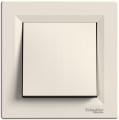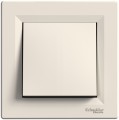Protection level
— IP20. Initial level of protection. Switches of this type can only be used in dry rooms with low dust content. The shell protects only from direct contact of the user's fingers with the bare parts of the mechanism. The first digit 2 is protection against the penetration of mechanical particles with a diameter of more than 12.5 mm. The second digit 0 is the complete lack of protection against the negative effects of moisture.
— IP21. Basic level of protection. Switches of this type can be used in rooms with low dust content, it is possible to work in a humid environment. The shell protects against vertically falling drops of water and direct contact of the user's fingers with bare parts of the mechanism. The first digit 2 is the protection of the electrocontact group from the penetration of mechanical particles with a diameter of more than 12.5 mm. The second number 1 is the initial protection against the negative effects of moisture. The shell withstands only vertically falling drops of water.
— IP22. Improved level of basic protection. Switches are suitable for work in rooms with low dustiness, operation in the damp environment is possible. The shell protects against drops of water falling at an angle of 15˚, as well as from contact of fingers with bare elements of the mechanism. The first digit 2 — the presence of protection against penetration under the body of mechanical particles with a diameter of more than 12.5 mm. The second number 2 i...s improved basic protection against wet environments. The body of the switch withstands drops of water falling at an angle of 15˚.
— IP31. Average level of protection. This category of switches is designed for operation in rooms with low dust content, operation near a water outlet is possible. The protective sheath isolates the electrocontact group from direct impact with a tool (screwdriver, tongs, etc.), as well as from vertically falling drops of water. The first digit 3 — protection against penetration under the body of particles with a diameter of more than 2.5 mm. The second digit 1 is protection against vertically falling drops of water.
— IP40. Medium level protection, but only in completely dry rooms. Switches endure the atmosphere of low dust content. The shell protects the switch mechanism from contact with a thin tool (awl, hairpin, etc.). Protection against the negative effects of moisture is completely absent. The first digit 4 is protection against particles with a diameter of more than 1 mm getting under the body. The second digit 0 is the complete lack of protection against moisture.
— IP44. Above average protection. The protective shell allows the switches to work confidently in rooms with a high level of humidity. The housing of the electrical accessories prevents contact with a thin tool with a diameter of more than 1 mm. The shell is resistant to water drops falling at any angle.
— IP54. Protection class for street switches. The shell partially prevents fine dust from getting under the body. The tightness of the shell is enough to isolate the electrocontact group from a short rain. Switches with a similar protection class are recommended to be installed under a street canopy. The first digit is 5 — the case partially isolates the switch mechanism from the penetration of fine dust. Blockages in the form of dust can get under the housing, but in small quantities. The second digit is 4 — the shell provides protection from short-term rain. The case is resistant to drops of water falling from different directions.
— IP55. The protective shell involves the placement of switches on the street. The tightness of the body is enough to partially isolate the electrocontact group from fine dust. The circuit breaker housing easily withstands operation in short-term heavy rain. This protection class allows outdoor placement of switches without a canopy. The first digit is 5 — the protective shell isolates the electrocontact group from fine dust. In this case, dust can get under the case, but its amount will be insufficient to disrupt the operation of the switch. The second digit is 5 — the tightness of the case is sufficient for the circuit breaker to operate under short-term heavy rain. Fittings endure work under running water.
— IK01. The switch buttons can withstand only a slight tactile impact. The IK01 protection standard allows a regular mechanical load with a force not exceeding 0.15 J. This mechanical load is equivalent to a 200 g load switch falling from a height of 7.5 cm. The IK01 protection class is the basic one for buttons and switches for domestic use.
— IK04. The circuit breakers are capable of withstanding an average mechanical load. IK04 provides protection for pushbuttons against a regular load of 0.5 J, which is equivalent to a load of 200 g from a height of 25 cm. Switches of this type can be installed in passageways.

